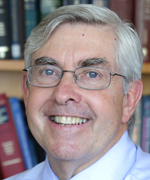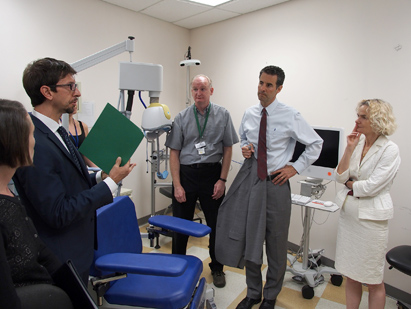News Briefs
CHINESE LEADERS GATHER WITH U.S. HEALTH OFFICIALS AT NIH

PHOTO BY ERNIE BRANSON
HHS Secretary Sylvia Burwell joined China’s Vice Premier Liu Yandong (center) and the minister of China’s National Health and Family Planning Commission, Li Bin, in signing a memorandum of understanding on infectious diseases.
Chinese Vice Premier Liu Yandong and Li Bin, minister of the National Health and Family Planning Commission of the People’s Republic of China, visited NIH June 24 and joined Sylvia Burwell, secretary of the Department of Health and Human Services (HHS); Jimmy Kolker, assistant secretary for global affairs at HHS; and NIH officials for a bilateral meeting on Ebola, research, and global-health security.
The officials were in Washington, D.C., for the sixth China–United States High-Level Consultation on People-to-People Exchange. This year marked the first time “health” was on the meeting agenda.
During the visit, HHS Secretary Burwell signed a memorandum of understanding—on behalf of the Centers for Disease Control and Prevention—with Minister Bin to promote closer cooperation, scientific discovery, capacity building, and exchange of information in the field of infectious diseases.

PHOTO BY ERNIE BRANSON
Experts at the NIH Clinical Center demonstrated technology that can assist and strengthen patients’ movement abilities. Pictured: Li Bin (fifth from right), the minister of China’s National Health and Family Planning Commission; NIH postbaccalaureate fellow Abhinav Sharma (on the treadmill); postdoc Zach Lerner (left of Sharma).
Bin and some of the other guests also visited Building 10. NIH Director Francis Collins and Clinical Center Director John Gallin gave an overview of the research hospital and escorted them to the Rehabilitation Medicine Department’s Clinical Movement Analysis Lab.
The visitors watched a demonstration of a newly designed motorized “smart” robotic exoskeleton while Clinical Center postdoctoral fellow Zach Lerner explained how the exoskeleton is designed to help children with cerebral palsy improve their ability to walk. The technology assists children who walk with excessive knee flexion, or crouch, by enabling them to have a more upright stride.
(From the July 2015 edition of the Clinical Center News: http://clinicalcenter.nih.gov/about/news/newsletter.html)
KOROSHETZ NAMED NINDS DIRECTOR
Walter Koroshetz was named director of the National Institute of Neurological Disorders and Stroke by NIH Director Francis Collins at the June 11 meeting of the Advisory Committee to the Director. Koroshetz came to NIH in 2007 as NINDS deputy director and has served as acting director since Story Landis retired in October 2014.

Walter Koroshetz was recently named director of the National Institute of Neurological Disorders and Stroke. He had been serving as acting director since Story Landis retired in October 2014.
“His deep grounding in clinical neurology and basic neuroscience research makes him the ideal candidate to lead NINDS into the future,” said Collins.
Collins also recognized Koroshetz’s role in the creation of StrokeNet, a national clinical-trial network for research in stroke treatment, prevention, and recovery; his role as point person for traumatic brain injury research at NIH; and being a co-founder of the NIH-Uniformed Services Center for Neuroscience and Regenerative Medicine.
Koroshetz came to NIH from Boston, where he served as vice chair of neurology and the director of stroke and neurointensive care services at Massachusetts General Hospital, head of its neurology resident-training program, and a professor of neurology—and co-director of the Neurobiology of Disease Course—at Harvard Medical School.
(From the July 3, 2105, edition of the NIH Record: http://nihrecord.nih.gov/newsletters/2015/07_03_2015/story1.htm)
PÉREZ-STABLE TO DIRECT NIMHD
Eliseo J. Pérez-Stable has been named director of the National Institute on Minority Health and Health Disparities. He is expected to join NIH in September.
Pérez-Stable will oversee the institute’s $270 million budget to conduct and support research, training, research capacity and infrastructure development, and public-education and information-dissemination programs to improve minority health and reduce health disparities.

The new director of the National Institute on Minority Health and Health Disparities, Eliseo J. Pérez-Stable, is expected to join NIH in September.
He comes to NIH from the University of California, San Francisco (UCSF), where he is a professor of medicine, chief of the division of general internal medicine, and director of the Center for Aging in Diverse Communities. The center works to alleviate health disparities with a focus on improving health care for aging minority populations and on diversifying the scientific workforce addressing these issues. He is also director of the UCSF Medical Effectiveness Research Center for Diverse Populations, which is addressing issues for African-Americans, Asians, and Latinos in the areas of cancer, cardiovascular disease, and reproductive health.
Pérez-Stable’s personal research interests are improving the health of poor and minority patients, reducing health risks such as smoking in minority populations, and improving cross-cultural communication skills among health-care professionals.
[From the August 14, 2015 issue of the NIH Record: http://nihrecord.nih.gov/newsletters/2015/08_14_2015/story4.htm]
CONGRESSMAN JOHN SARBANES VISITS NIDA

On August 24, Congressman John Sarbanes of Maryland visited the National Institute on Drug Abuse’s (NIDA) intramural research facility in East Baltimore, Maryland. While at the facility, Congressman Sarbanes met with NIDA Director Nora Volkow and Scientific Director Antonello Bonci to discuss the latest addiction research being conducted. Volkow and Bonci guided Sarbanes on a tour of the facility, which included viewing the cutting-edge clinical and basic research laboratories and tools being used to help further what is known about drug addiction. Sarbanes was led through the Archway Clinic, which conducts studies with human volunteers to better understand, treat, and prevent drug abuse and dependence. At the end of the tour, Volkow and Bonci showcased NIDA’s brain-imaging capabilities so Sarbanes could see the manipulation of brain cells at the neuron level. Pictured, from left: NIDA Scientific Director Antonello Bonci, NIDA staff scientist Thomas Ross, Congressman John Sarbanes, and NIDA Director Nora Volkow.
This page was last updated on Monday, April 25, 2022
